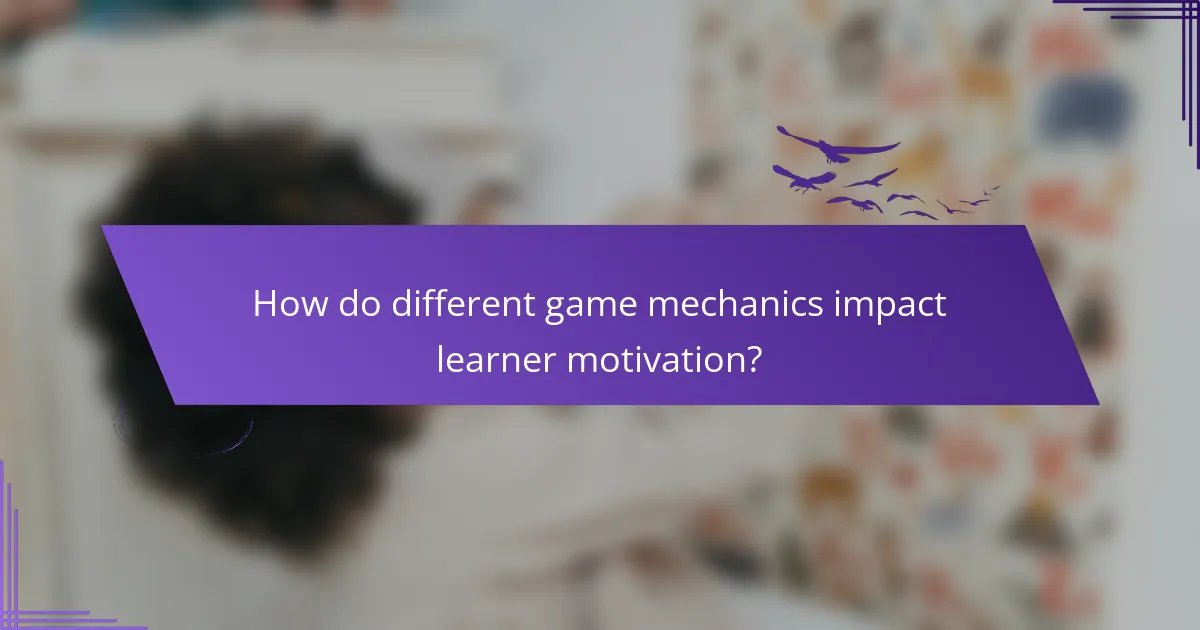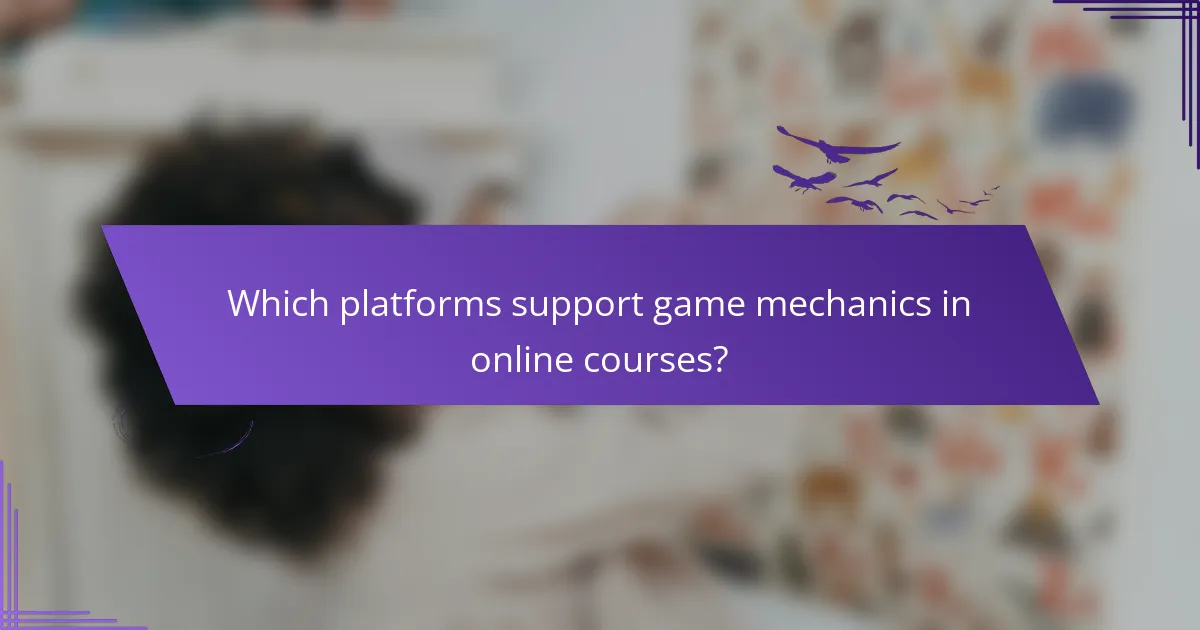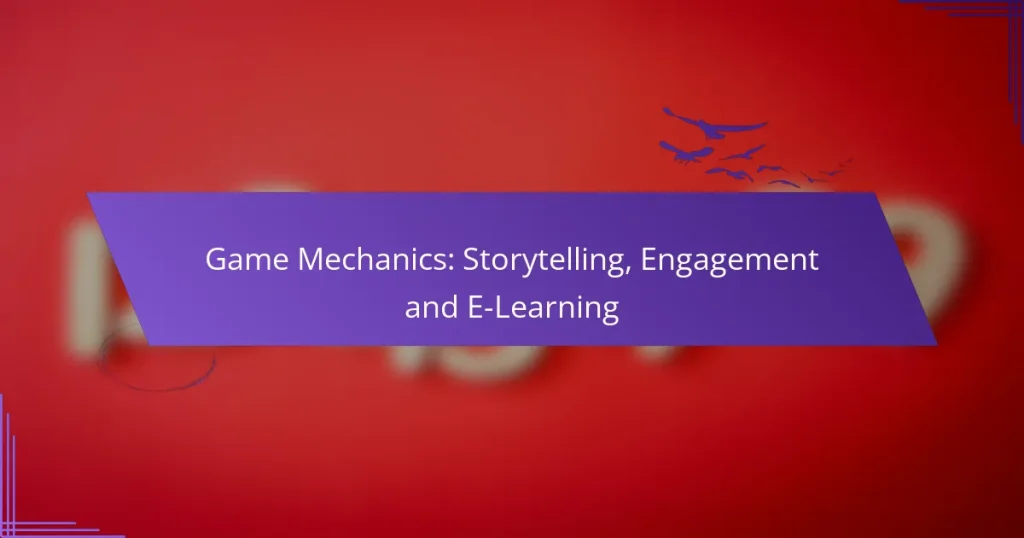Game mechanics play a crucial role in enhancing storytelling and engagement in e-learning environments. By incorporating interactive elements such as narratives, character development, and reward systems, educators can create immersive experiences that not only captivate learners but also improve knowledge retention. These strategies foster motivation and participation, ultimately leading to a more effective and enjoyable learning journey.

How can game mechanics enhance storytelling in e-learning?
Game mechanics can significantly enhance storytelling in e-learning by creating engaging and interactive experiences that captivate learners. By integrating elements like narratives, character development, and immersive environments, educators can foster deeper understanding and retention of the material.
Interactive narratives
Interactive narratives allow learners to engage with the story actively, making choices that affect the outcome. This engagement can lead to a more personalized learning experience, as students feel a sense of ownership over their journey. For instance, a history lesson could present scenarios where learners decide the actions of historical figures, influencing the course of events.
Character development
Character development in e-learning helps learners connect emotionally with the content. By creating relatable characters that evolve throughout the story, students can see the consequences of decisions and actions. For example, a character facing ethical dilemmas can illustrate complex concepts in business ethics, making the lessons more memorable.
Branching storylines
Branching storylines provide multiple paths through the content, allowing learners to explore different outcomes based on their choices. This structure encourages critical thinking and decision-making skills. A language learning module might present various scenarios where learners choose how to respond, reinforcing vocabulary and grammar in context.
Immersive environments
Immersive environments enhance the storytelling experience by placing learners in realistic settings that reflect the subject matter. Virtual or augmented reality can transport students to historical sites or scientific labs, making the learning experience more vivid. For example, a biology course could use a virtual lab to simulate experiments, allowing hands-on practice without real-world risks.
Feedback loops
Feedback loops are essential in e-learning as they provide learners with immediate responses to their actions, reinforcing learning. Effective feedback can guide students through the narrative, highlighting areas for improvement and celebrating successes. Incorporating quizzes or challenges at key points in the story can help maintain engagement and assess understanding in real-time.

What are effective engagement strategies using game mechanics?
Effective engagement strategies using game mechanics involve integrating elements like point systems, leaderboards, and achievement badges to motivate and retain learners. These strategies enhance participation and create a more immersive learning experience.
Point systems
Point systems reward users for completing tasks, participating in activities, or achieving specific goals. By assigning points for various actions, learners can track their progress and feel a sense of accomplishment. For example, a language learning app might give users points for daily practice, encouraging consistent engagement.
When implementing a point system, ensure that the rewards are meaningful and attainable. Avoid overwhelming users with excessive points for minor tasks, as this can dilute motivation. A balanced approach keeps learners engaged without feeling discouraged.
Leaderboards
Leaderboards display users’ rankings based on their performance, fostering a sense of competition and community. They can motivate learners to improve their skills and engage more deeply with the content. For instance, a coding platform might show the top performers in a coding challenge, encouraging others to participate.
However, consider the potential downsides of leaderboards. They can discourage those who consistently rank low, so it’s essential to create multiple categories or tiers to accommodate various skill levels. This inclusivity helps maintain motivation across a broader audience.
Achievement badges
Achievement badges serve as visual rewards for reaching specific milestones or completing challenges. They provide learners with tangible recognition of their efforts, enhancing their sense of accomplishment. For example, a fitness app might award badges for completing a certain number of workouts or achieving personal bests.
To maximize the impact of achievement badges, ensure they are diverse and cater to different interests and skills. This variety allows users to pursue badges that resonate with them, increasing their engagement and motivation to explore more content.
Time-based challenges
Time-based challenges create urgency and excitement by setting a deadline for completing tasks or achieving goals. These challenges can stimulate learners to focus and enhance their time management skills. For instance, a trivia game might offer points for answering questions within a limited timeframe.
When designing time-based challenges, consider the appropriate duration to balance excitement and pressure. Short challenges can create a fast-paced environment, while longer ones may allow for deeper engagement. Test different time limits to find what best suits your audience.
Social interactions
Social interactions encourage collaboration and communication among learners, enhancing engagement through shared experiences. Features like discussion forums, team challenges, or peer feedback can foster a sense of community. For example, an online course might include group projects that require learners to work together to solve problems.
To facilitate effective social interactions, provide clear guidelines and support for collaboration. Encourage users to share their insights and experiences, which can enrich the learning environment. Be mindful of moderating discussions to maintain a positive and constructive atmosphere.

How do different game mechanics impact learner motivation?
Different game mechanics significantly influence learner motivation by fostering engagement and enhancing the learning experience. By incorporating elements such as intrinsic motivation, extrinsic rewards, goal setting, and progress tracking, educators can create a more compelling and effective learning environment.
Intrinsic motivation
Intrinsic motivation refers to the internal drive to engage in an activity for its own sake, rather than for external rewards. In e-learning, this can be cultivated through meaningful content that resonates with learners’ interests and goals. For example, allowing learners to choose topics or projects that align with their passions can enhance their intrinsic motivation.
To boost intrinsic motivation, consider incorporating storytelling elements that connect the material to real-world scenarios. This approach can make learning more relatable and enjoyable, encouraging learners to delve deeper into the subject matter.
Extrinsic rewards
Extrinsic rewards are external incentives that encourage participation and achievement, such as badges, certificates, or even monetary prizes. These rewards can effectively motivate learners, especially in competitive environments. However, it’s essential to balance extrinsic rewards with intrinsic motivation to avoid diminishing the learners’ internal drive.
When implementing extrinsic rewards, ensure they are meaningful and relevant to the learning objectives. For instance, offering a certificate for completing a course can provide a tangible goal for learners, reinforcing their commitment to the learning process.
Goal setting
Goal setting involves establishing clear, achievable objectives that guide learners through their educational journey. By setting specific, measurable, attainable, relevant, and time-bound (SMART) goals, learners can maintain focus and motivation. This method helps learners track their progress and celebrate milestones, which can further enhance their engagement.
Encourage learners to set personal goals alongside course objectives. This dual approach can foster a sense of ownership and accountability, making the learning experience more impactful and motivating.
Progress tracking
Progress tracking allows learners to visualize their advancement and achievements over time. By providing regular feedback and updates on their performance, learners can identify areas for improvement and stay motivated. Tools such as dashboards or progress bars can make this tracking more engaging and informative.
Implementing a system for progress tracking should include both quantitative metrics, like scores or completion rates, and qualitative feedback. This combination helps learners understand their strengths and weaknesses, fostering a growth mindset that encourages continued effort and improvement.

What prerequisites are needed for implementing game mechanics in e-learning?
Implementing game mechanics in e-learning requires a clear understanding of learning objectives, a robust technical infrastructure, and well-aligned content. These prerequisites ensure that the gamified elements enhance the educational experience rather than detract from it.
Understanding of learning objectives
Before integrating game mechanics, it’s crucial to define clear learning objectives. These objectives guide the design of the game elements, ensuring they support educational goals rather than distract from them.
Consider using the SMART criteria—Specific, Measurable, Achievable, Relevant, and Time-bound—to formulate your objectives. For example, instead of a vague goal like “improve knowledge,” specify “increase knowledge of basic algebra concepts by 30% within three months.”
Technical infrastructure
A solid technical infrastructure is essential for implementing game mechanics effectively. This includes reliable software platforms, user-friendly interfaces, and adequate hardware to support interactive elements.
Evaluate your current systems to ensure they can handle gamified content. For instance, if using a Learning Management System (LMS), check if it supports game-based features like leaderboards or badges. Upgrading to a more advanced LMS may be necessary if your current setup lacks these capabilities.
Content alignment
Content must align with both the learning objectives and the game mechanics to create a cohesive experience. Ensure that game elements reinforce the material being taught and engage learners in meaningful ways.
For example, if your objective is to teach historical events, consider using a role-playing game format where learners assume the roles of historical figures. This approach not only makes learning interactive but also deepens understanding through immersive experiences.

Which platforms support game mechanics in online courses?
Several platforms effectively integrate game mechanics into online courses, enhancing engagement and learning outcomes. Popular options include Moodle, Canvas, and Edmodo, which allow educators to incorporate elements like points, badges, and leaderboards.
Moodle
Moodle is a widely used learning management system (LMS) that supports various game mechanics through plugins and built-in features. Educators can create quizzes with points, set up badges for achievements, and implement conditional activities to motivate learners. This flexibility makes Moodle suitable for diverse educational settings.
Canvas
Canvas offers a user-friendly interface and supports game-based learning through its mastery paths and badge systems. Instructors can design courses that adapt to student performance, rewarding progress with badges and certificates. This approach fosters a sense of accomplishment and encourages continued participation.
Edmodo
Edmodo is another platform that promotes engagement through game mechanics by allowing teachers to create assignments with points and badges. The social aspect of Edmodo encourages collaboration and competition among students, making learning more interactive. Teachers can also track progress and provide feedback, enhancing the overall learning experience.

